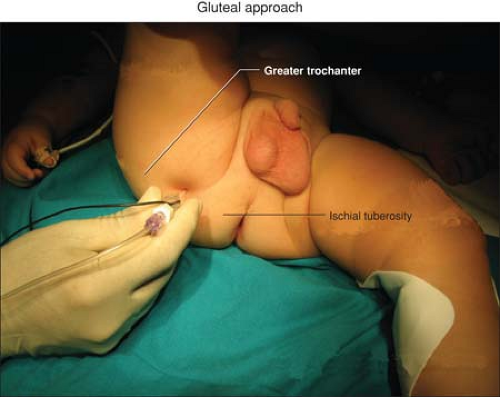A. Posterior Approach
 Patient Position:
Patient Position: The child is placed in the lateral position, hip flexed at 120°, knee flexed at 90°, or both knees against the abdomen.
 Indications:
Indications: Anesthesia and postoperative analgesia for foot, ankle, and knee. In combination with femoral nerve block for surgery on the whole leg.
 Needle Size:
Needle Size: A 22-gauge, 50- to 100-mm, insulated beveled needle.
 Volume:
Volume: Ropivacaine 0.2% for children up to 7 years, levobupivacaine 0.5% for older children, 0.5 to 0.7 mL/kg.
 Anatomic Landmarks:
Anatomic Landmarks: The great trochanter, the coccyx, the ischial tuberosity
 Approach and Technique:
Approach and Technique: Many approaches have been described but the easiest way, by Dalens, is to mark a line from the skin projection of the great trochanter to the coccyx; the point of insertion of the needle is the midpoint of this line, perpendicular to the skin, pointing to the ischial tuberosity. Since the sciatic nerve is too deep it is impossible to detect it via transcutaneous stimulation. Therefore, insert the needle connected to the nerve stimulator set at 1 mA and 2 Hz, and advance it until the motor response of the foot and toes is elicited (dorsiflexion of the toes and foot or eversion following stimulation of the common peroneal nerve, or plantar flexion of the toes and foot or inversion following stimulation of the tibial nerve). Adjust the position of the needle to maintain the appropriate muscle response with a current of 0.4 to 0.5 mA. Then, after negative aspiration, slowly inject the local anesthetic solution.
 Tips
Tips
There are no particular contraindications or side effects except the vessel puncture of the inferior gluteal artery.
A potential error could be the local anesthetic injection upon stimulatory response from the gluteal muscles.
A combined sciatic and femoral or saphenous nerve block can be used for most lower extremity surgeries. In this case the total dose of local anesthetic must be reduced for each block.
Suggested Reading
Dalens B, Tanguy A, Vanneuvile G. Sciatic nerve block in children: a comparison of the posterior, anterior and lateral approaches in 180 paediatric patients. Anaesth Analg 1990;70:131.
B. Gluteal Approach
 Patient Position:
Patient Position: Very easy to perform in small children, supine with both the leg maintained flexed on the abdomen at 90° and the knee flexed at 90° helped by a nurse.
 Indications:
Indications: Anesthesia and immediate postoperative analgesia for foot, ankle, and knee. In combination with femoral nerve block for surgery on the whole leg.
 Needle Size:
Needle Size: A 22- to 25-gauge, 50- to 100-mm, insulated beveled needle.
 Volume:
Volume: Ropivacaine 0.2% for children up to 7 years, levobupivacaine 0.5% for older children, 0.5 to 0.7 mL/kg.
 Anatomic Landmarks:
Anatomic Landmarks: The greater trochanter of the femur and the ischial tuberosity
(Fig. 48-1).
 Approach and Technique:
Approach and Technique: The shorter distance from skin to nerve compared with the posterior approach allows the use of nerve mapping, then insert the needle perpendicular to the skin in the midpoint of the line joining the greater trochanter with the ischial tuberosity. Connect to the nerve stimulator set at 1.5 mA and 2 Hz, and advance it until the motor response of the foot and toes is elicited (dorsiflexion of the toes and foot or eversion
following stimulation of the common peroneal nerve, or plantar flexion of the toes and foot or inversion following the stimulation of the tibial nerve). Adjust the position of the needle to maintain the appropriate muscle response with a current of 0.4 to 0.5 mA. Then, after negative aspiration, slowly inject the local anesthetic solution.
 Tips
Tips
There are no particular contraindications or side effects except the vessel puncture of the inferior gluteal artery.
A potential error could be the local anesthetic injection upon stimulatory response from the gluteal muscles.
A combined sciatic and femoral or saphenous nerve block can be used for most lower extremity surgeries. In this case the total dose of local anesthetic must be reduced for each block.
In older children this block can be performed placing the patient in lateral position with the same landmarks.






